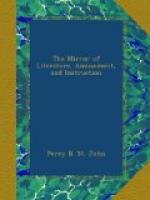The reader will perhaps think we give only the “milk and honey” of these letters, but they bear the stamp of authenticity.
* * * * *
KENILWORTH.
Every body knows the delightful romance of Kenilworth,—a tragedy, of which the dramatis personae are the parties themselves, called up from their graves by the novelist magician. Students who attend St. Mary’s Church, Oxford, still look out for the flat stone which covers the dust and bones of poor Amy, and could any sculptured effigies supply the place of the whole historical picture, then imagined in the mind’s eye? More than once attracted by the old ballad,[1] we have, when undergraduates, walked to the “lonely towers of Cumnor Hall,” fancied that we saw her struggle, and heard her screams, when she was thrown over the staircase (the traditional mode of her assassination,) and wondered how any man could have the heart to murder a simple lovesick pretty girl. Even now, in sorrow and in sadness, we read this account:—
The unfortunate Amye Duddley (for so she subscribes herself in the Harleian Manuscript, 4712,) the first wife of Lord Robert Dudley, Queen Elizabeth’s favourite, and after Amy’s death Earl of Leicester, was daughter of Sir John Robsart. Her marriage took place June 4, 1550, the day following that on which her lord’s eldest brother had been united to a daughter of the Duke of Somerset, and the event is thus recorded by King Edward in his Diary: “4. S. Robert dudeley, third sonne to th’ erle of warwic, married S. John Robsartes daughter; after wich mariage ther were certain gentlemen that did strive who shuld first take away a gose’s heade wich was hanged alive on tow crose postes.” Soon after the accession of Elizabeth, when Dudley’s ambitious views of a royal alliance had opened upon him, his countess mysteriously died at the retired mansion of Cumnor near Abingdon,[2] Sept. 8, 1560; and, although the mode of her death is imperfectly ascertained (her body was thrown down stairs, as a blind,) there appears far greater foundation for supposing the earl guilty of her murder, than usually belongs to such rumours, all her other attendants being absent at Abingdon fair, except Sir Richard Verney and his man. The circumstances, distorted by gross anachronisms, have been weaved into the delightful romance of “Kenilworth.”
Of the goose and posts, we can suggest no better explanation than that the goose was intended for poor Amy, and the cross posts for the Protector Somerset, and his rival Dudley Duke of Northumberland, both of whom were bred to the devil’s trade, ambition. Others may be possessed of more successful elucidation. At all events, it is plain that the people had a very suspicious opinion of Leicester, amounting to this, that he was a great rascal, who played a deep game, and stuck at nothing which he could do without danger to himself.[3]—Gentleman’s Magazine.




